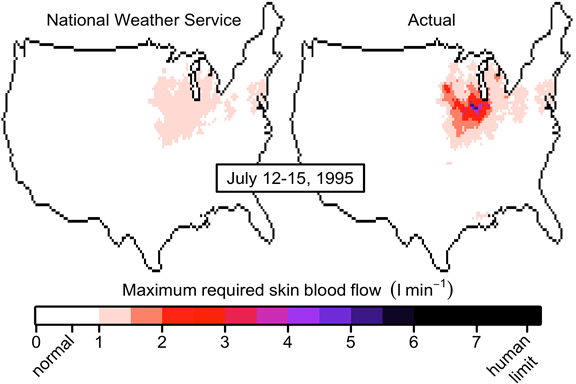The heat index has been underreported, and by a lot
Submitter
Romps, David — Lawrence Berkeley National Laboratory
Area of research
Surface Properties
Journal Reference
Science
The National Weather Service (NWS) has systematically underestimated the heat index during severe heat waves by as much as 20 degrees Fahrenheit.
The NWS reports the heat index as a "feels like" temperature during hot and muggy conditions. But, unfortunately, the NWS uses a polynomial fit to extrapolate the heat index out to very hot conditions. So how good is that extrapolation? As it turns out, not so good. For example, during the July 1995 heat wave, which killed hundreds of people in Chicago, we find that the NWS underestimated the heat index by as much as 20 degrees Fahrenheit.
Impact
The heat index is based on how a person's body regulates its temperature. In hot conditions, each value of the heat index maps onto a unique physiological state, so the heat index tells us how stressful or unhealthy the heat and humidity are. By underestimating the heat index, the NWS has underestimated the health risk during severe heat waves. For example, during the July 1995 heat wave, the real heat index implies a cardiovascular stress approaching the physiological limit, an effect the NWS approximation does not capture.
Summary
The National Weather Service (NWS) reports the heat index in summertime, telling the public what the combination of temperature and humidity feels like. The heat index is supposed to be based on a model of human thermoregulation, introduced by Robert Steadman in his seminal 1979 paper. Unfortunately, that paper did not calculate the heat index out to high heat and humidity, so the NWS uses a polynomial fit to extrapolate the heat index out to very hot conditions. So how good is that extrapolation?
In a recent paper, we extended Steadman's heat index to all combinations of temperature and humidity, so now we can check how well the NWS approximation performs. Using the extended heat index to rank US heat waves from 1984 to 2020, we find that the top two heat waves occurred in the Midwest in July 2011 and July 1995. During those events, a person's cardiovascular system would have been taxed with a skin blood flow that was elevated severalfold, approaching the physiological limit. These effects are not captured by the National Weather Service's polynomial extrapolation, which systematically underestimates the heat index during severe heat waves by as much as 20 degrees Fahrenheit.


